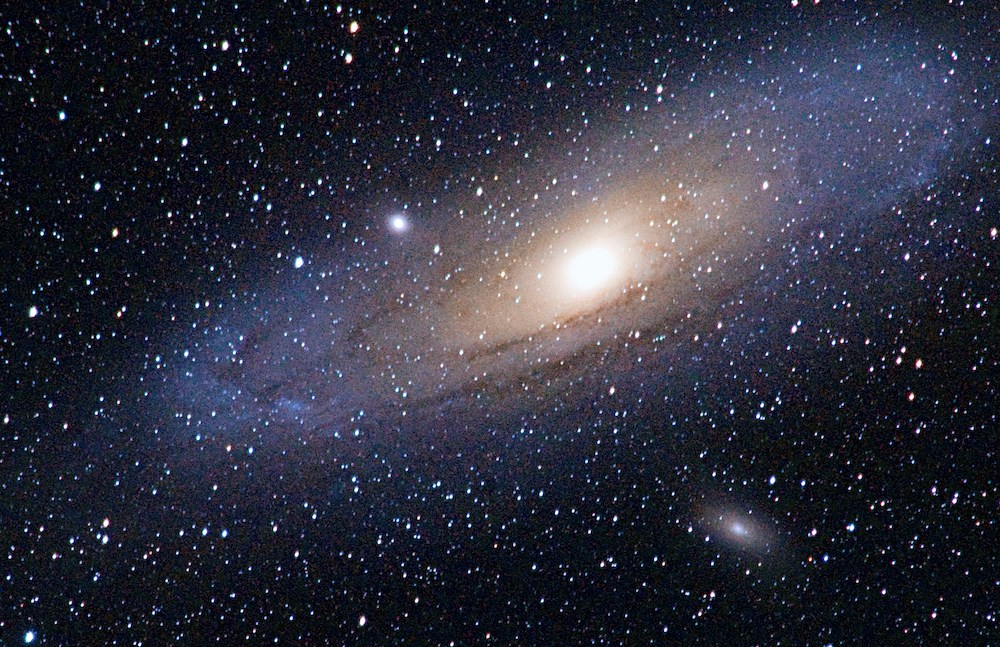
November 2023 has its share of some close passes by the moon with various solar system objects. One of the precursors will be in the evening of Oct. 29 when the moon passes about 3 degrees north of Jupiter. Jupiter reaches opposition (directly opposite the sun) on Nov. 3, so we’ll be at our closest and that planet and its moons will be at their brightest and easiest to see. Watching Jupiter’s four big moons – Io, Europa, Ganymede and Callisto – do their intricate dance around the planet is always fascinating and I always wonder how mind-blowing it must have been for Galileo to realize what he was watching in 1610 or so.
The moon does another close pass on Nov. 9, this time by Venus. At 03:30 and due East, the very thin crescent moon and Venus rise about one degree apart. Interestingly, with a good telescope, you would see Venus looking like a last-quarter moon. The moon looks so thin because it’s much closer to us than the sun and only a sliver that we see gets sunlight. Venus, however, is just about the same distance as the sun and we see the sunward half of it lit.
Later, the moon makes a pass by Saturn on Nov. 20 in the evening and by Jupiter on Nov. 24. Although I’ve never managed to see it with binoculars, Saturn’s big moon, Titan, ought to be visible with 10x or greater as long as you can stabilize the binocs with a tripod. Jupiter’s moons are more easily visible (half as far away and brighter), easy in a telescope but doable with just binoculars most of the time. I use the Royal Astronomical Society of Canada’s Observer’s Handbook to figure out the best views but Stellarium can show them to you with amazing accuracy and it’s free, so there’s no excuse for not having a look.
The International Space Station finishes up its routine of morning passes in early November, takes a break, then resumes evening appearances around mid-month. Heavens-Above has the best info on these.
The somewhat cryptic title of this article is because it’s been one hundred years since an astronomer proved that a certain nebula in the constellation of Andromeda was definitely farther away than other objects in our sky. At the time, there was no consensus on how far away many objects actually were. We must remember that there were then very few large telescopes and all were limited to the visual spectrum. Astrophotographic records were limited to very slow black-and-white pictures recorded on glass plates. Distance estimates for some stars were made by calculating the changes in position of nearby stars as Earth moved around its orbit but most objects were too far away to show the effects of parallax. While it was well understood that stars appeared dimmer when farther away, it was not straightforward whether a given star was big and bright and far away or smaller, dimmer and nearby. Spectral analysis (colour) gives you some idea of the brightness of main sequence stars but it’s the weird ones – the short-lived giants – that confuse everything. Betelgeuse, for example, is roughly the same colour as the many dull red dwarf stars around us but it’s 650 light years or so away and is so bright because it’s a red supergiant star about to blow itself to bits in a supernova.
One solution to this problem began to appear with the discovery of certain variable stars in the eighteenth century. Called Cepheid variables after the prototype star Delta Cepheus, they display regular variations in brightness ranging from a few days to a few weeks. By 1912, enough of these had been observed to correlate their absolute magnitude with the period; basically, the greater the absolute magnitude, the longer the period of the cycle. Remember, it can take months to get enough good data on a single star to establish if it varies and 10 times that to determine if it’s regular – not easy!
Regardless, a certain astronomer spent much of his time looking for Cepheid-type stars in the Andromeda nebula; on Oct. 4, 1923, he recorded a photo of the nebula using the 100-inch Hooker telescope.
Over the next few months, he discovered that one unusually bright star he’d recorded was not a one-time flareup but a Cepheid-type variable. That gave him the correlation he needed to prove that the nebula had to be well beyond all the other objects visible in our sky – that the Andromeda “nebula” was no gas-and-stars cloud like some Milky Way objects but another separate galaxy similar to our own. Within the space of a few years many more galaxies had been established, their spectral red shifts had been proven to mean they were receding from us, the universe was huge and clearly expanding and our understanding of it had changed immeasurably. The man’s name was Edwin Hubble, (1889 – 1953). He’d be stunned to know what we’ve discovered with his namesake telescope.
The Sunshine Coast Astronomy Club’s monthly meeting will be at the Sechelt Library at 7 p.m., Nov. 10, at which The Sky This Month will be presented. Please check the club website at: https://sunshinecoastastronomy.wordpress.com/ for the subject of the guest lecture. Refreshments may include coffee, cookies and carrot cake.
https://news.google.com/rss/articles/CBMiamh0dHBzOi8vd3d3LmNvYXN0cmVwb3J0ZXIubmV0L2luLXRoZS1jb21tdW5pdHkvc2VjaGVsdC1za2llcy13aHktdGhlLWh1YmJsZS10ZWxlc2NvcGUtaGFzLWl0cy1uYW1lLTc3NDk0NTXSAQA?oc=5
2023-10-28 00:55:00Z
CBMiamh0dHBzOi8vd3d3LmNvYXN0cmVwb3J0ZXIubmV0L2luLXRoZS1jb21tdW5pdHkvc2VjaGVsdC1za2llcy13aHktdGhlLWh1YmJsZS10ZWxlc2NvcGUtaGFzLWl0cy1uYW1lLTc3NDk0NTXSAQA
Tidak ada komentar:
Posting Komentar